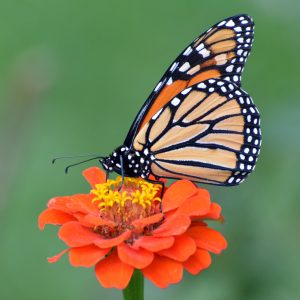
Photo Credit: Peter Miller
This week, we’re looking at the strategies and counter-strategies that Monarch butterflies have developed in courtship and reproduction.
Once females emerge from their chrysalises they are able to mate, but they have an incentive to wait. If they reach their full grown size, which is some weeks after emergence, the females are larger; this means they can create bigger eggs and bigger offspring. Stronger, bigger offspring are more likely to survive in the harsh wilds. After all, we all want what’s best for our children, right? When female Monarch decides to mate, they will release pheromones to attract the males.
The attracted males will grab a flying female or male, bring her to the ground, and try to mate with her. About 1/3 of sexual interactions are male/male pairings and are of the same length as male/female copulation sessions. If a male brings a female to the ground, one of two things will happen: the female will resist or she will accept the male’s advancements. If she allows the male to mate with her, then her eggs may become fertilized in an up to 16 hour sex session. But the female can mate with many males and has developed a really cool way to choose who fertilizes her eggs.
Females can keep the bundle of sperm, called a spermatophore, for nutrients if they don’t find the male suitable. If they find the male suitable, she will allow his sperm to fertilize her eggs. To increase their chances to propagate their own line, males have developed some clever behaviour.

Two Monarch Butterflies Mating, Photo Credit: Mike Baird
Usually, whichever male mates with a female last will father her children. Since Monarch butterflies are only active during the day, males will try to copulate with females in the evening so that they can be the last males to mate with a female on that day, and hopefully be the last male to mate with that female before she lays her eggs. The male and female Cabbage Butterfly have also developed sexual adaptations that are similar to the Monarch Butterfly, but theirs involve teeth, of sorts.
The monarch butterfly is an endangered species. Though they don’t live in Vancouver, other pollinators need your help. Learn more about how you can support your local bees, butterflies, and other pollinators with some simple changes.
Interested in learning more about the mating behaviours of different plants, animals, and fungi? Check back here for more Mating Mondays.
For more information on insects, arachnids, other terrestrial invertebrates, check out the Spencer Entomological Collection.
